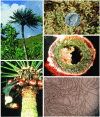Biomagnification of cyanobacterial neurotoxins and neurodegenerative disease among the Chamorro people of Guam
- PMID: 14612559
- PMCID: PMC263822
- DOI: 10.1073/pnas.2235808100
Biomagnification of cyanobacterial neurotoxins and neurodegenerative disease among the Chamorro people of Guam
Abstract
We here report biomagnification (the increasing accumulation of bioactive, often deleterious molecules through higher trophic levels of a food chain) of the neurotoxic nonprotein amino acid beta-methylamino-l-alanine (BMAA) in the Guam ecosystem. Free-living cyanobacteria produce 0.3 microg/g BMAA, but produce 2-37 microg/g as symbionts in the coralloid roots of cycad trees. BMAA is concentrated in the developing reproductive tissues of the cycad Cycas micronesica, averaging 9 microg/g in the fleshy seed sarcotesta and a mean of 1,161 microg/g BMAA in the outermost seed layer. Flying foxes (Pteropus mariannus), which forage on the seeds, accumulate a mean of 3,556 microg/g BMAA. Flying foxes are a prized food item of the indigenous Chamorro people who boil them in coconut cream and eat them whole. Chamorros who die of amyotrophic lateral sclerosis/parkinsonism-dementia complex (AL-SPDC), a neurodegenerative disease with symptoms similar to amyotrophic lateral sclerosis, Parkinson's disease, and Alzheimer's disease, have an average of 6.6 microg/g BMAA in their brain tissues. The biomagnification of BMAA through the Guam ecosystem fits a classic triangle of increasing concentrations of toxic compounds up the food chain. This may explain why the incidence of ALS-PDC among the Chamorro was 50-100 times the incidence of amyotrophic lateral sclerosis elsewhere. Biomagnification of cyanobacterial BMAA may not be unique to Guam; our discovery of BMAA in the brain tissue from Alzheimer's patients from Canada suggests alternative ecological pathways for the bioaccumulation of BMAA in aquatic or terrestrial ecosystems.
Figures



References
-
- Vega, A. & Bell, E. A. (1967) Phytochemistry 6, 759-762.
-
- Spencer, P. S., Nunn, P. B., Hugon, J., Ludolph, A. C., Ross, S. M. & Roy, D. N. (1987) Science 237, 517-522. - PubMed
-
- Duncan, M. W., Steele, J. C., Kopin, I. J. & Markey, S. P. (1990) Neurology 40, 767-772. - PubMed
-
- Cox, P. A. & Sacks, O. W. (2002) Neurology 58, 956-959. - PubMed
-
- Monson, C. S., Banack, S. A. & Cox, P. A. (2003) Conserv. Biol. 17, 678-686.
Publication types
MeSH terms
Substances
LinkOut - more resources
Full Text Sources
Other Literature Sources
Medical
Miscellaneous

